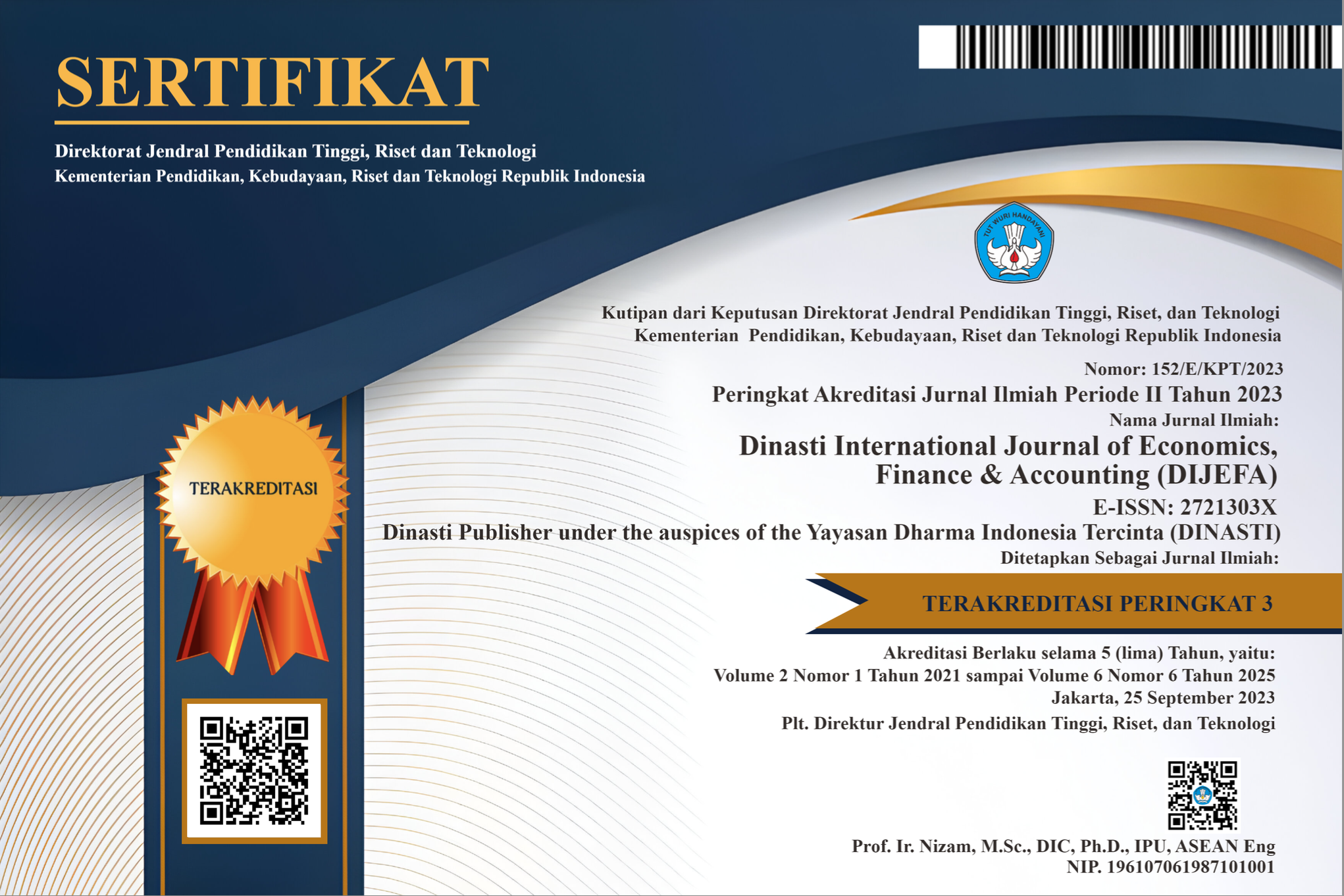Marketing Innovation as a Catalyst for Clean Energy Technology Diffusion: A Quantitative Analysis of Market Penetration Strategies
DOI:
https://doi.org/10.38035/dijefa.v5i5.3434Keywords:
Marketing Innovation, Diffusion of Clean Energy Technology, Market PenetrationAbstract
Although the global transition to clean energy has become a priority, the diffusion of clean energy technologies still faces significant challenges, especially in terms of market penetration. Marketing innovation is emerging as a potential catalyst for accelerating adoption, but quantitative understanding of its impact is still limited. This study aims to quantitatively analyze the influence of marketing innovation on the diffusion of clean energy technology, with a focus on market penetration among the millennial generation in Jakarta. Using a cross-sectional research design, data was collected through an online survey of 150 millennial respondents, adapting a structured questionnaire from previous studies. Data analysis was carried out using Structural Equation Modeling with the Partial Least Squares (SEM-PLS) approach to test the relationship between marketing innovation variables, consumer awareness, adoption intentions, and clean energy technology market penetration. The results of the research are expected to provide valuable insights for industry players and policymakers in designing effective marketing strategies to accelerate the adoption of clean energy technologies, as well as contributing to the academic literature on innovation diffusion in the context of the energy transition.
References
Khan, M. A., Ali, S., & Hussain, R. (2021). Barriers to the adoption of renewable energy technologies: A review of literature. Renewable and Sustainable Energy Reviews, 145, 111059.
Zhang, Y., Wang, J., & Liu, T. (2022). The role of marketing in promoting renewable energy technologies: A systematic review. Journal of Cleaner Production, 330, 129751.
Smith, J., & Brown, L. (2023). Marketing strategies for clean energy technology adoption: A quantitative approach. Energy Policy, 162, 112827.
Lee, K., Chen, H., & Kim, S. (2023). Understanding the impact of marketing innovation on the diffusion of clean energy technologies. Journal of Business Research, 154, 113-125.
Agarwal, N., & Sarangee, K. (2022). The role of marketing innovation in accelerating clean energy adoption: A meta-analysis. Journal of Cleaner Production, 330, 129751.
IPCC. (2022). Climate Change 2022: Mitigation of Climate Change. Contribution of Working Group III to the Sixth Assessment Report of the Intergovernmental Panel on Climate Change.
Kotilainen, K., Aalto, P., & Salonen, A. (2023). Accelerating clean energy transitions through innovative marketing strategies: A cross-country analysis. Energy Research & Social Science, 96, 102940.
Lee, K., & Heo, I. (2022). Consumer adoption of renewable energy technologies: The mediating role of innovative marketing approaches. Renewable and Sustainable Energy Reviews, 162, 112403.
Nemet, G. F., Callaghan, M. W., Creutzig, F., & Minx, J. C. (2023). Accelerating net-zero: Exploring the role of marketing innovation in scaling up clean energy technologies. Nature Energy, 8(4), 320-332.
Wang, X., Zhu, Y., & Chen, J. (2020). Diffusion of clean energy technologies: The role of marketing strategies in overcoming adoption barriers. Energy Policy, 147, 111880.
Zhang, L., Bai, W., & Liu, M. (2021). Marketing innovation as a driver for clean energy technology adoption: A systematic review and future research agenda. Technological Forecasting and Social Change, 166, 120639.
Creswell, J. W., & Creswell, J. D. (2022). Research design: Qualitative, quantitative, and mixed methods approaches (6th ed.). SAGE Publications.
Hair, J. F., Black, W. C., Babin, B. J., & Anderson, R. E. (2021). Multivariate data analysis (9th ed.). Cengage Learning.
Henseler, J., Hubona, G., & Ray, P. A. (2016). Using PLS path modeling in new technology research: Updated guidelines. Industrial Management & Data Systems, 116(1), 2-20.
Lee, K., & Heo, I. (2022). Consumer adoption of renewable energy technologies: The mediating role of innovative marketing approaches. Renewable and Sustainable Energy Reviews, 162, 112403.
Pew Research Center. (2023). Millennials and clean energy adoption: Trends and implications. Pew Research Center.
Zhang, L., Bai, W., & Liu, M. (2021). Marketing innovation as a driver for clean energy technology adoption: A systematic review and future research agenda. Technological Forecasting and Social Change, 166, 120639.
Downloads
Published
How to Cite
Issue
Section
License
Copyright (c) 2024 Nur Endah Retno Wuryandari, Setiyo Purwanto, Ari Apriani

This work is licensed under a Creative Commons Attribution 4.0 International License.
Authors who publish their manuscripts in this journal agree to the following conditions:
- The copyright on each article belongs to the author(s).
- The author acknowledges that the Dinasti International Journal of Economics, Finance & Accounting (DIJEFA) has the right to be the first to publish with a Creative Commons Attribution 4.0 International license (Attribution 4.0 International (CC BY 4.0).
- Authors can submit articles separately, arrange for the non-exclusive distribution of manuscripts that have been published in this journal into other versions (e.g., sent to the author's institutional repository, publication into books, etc.), by acknowledging that the manuscript has been published for the first time in the Dinasti International Journal of Economics, Finance & Accounting (DIJEFA).


























































